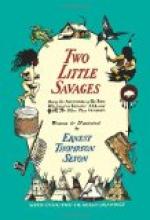So Burns left them, and a few minutes later Guy sneaked out of the woods to take a secondary part in the proceedings.
Caleb showed them how to split the skin along the under side of each leg and up the belly. It was slow work skinning, but not so unpleasant as Yan feared, since the animal was fresh.
Caleb did the most of the work; Sam and Yan helped. Guy assisted with reminiscences of his own Calf-skinning and with suggestions drawn from his vast experiences.
When the upper half of the skin was off, Caleb remarked: “Don’t believe we can turn him over, and when the Injuns didn’t have a Horse at hand to turn over the Buffalo they used to cut the skin in two down the line of the back. I guess we better do that. We’ve got all the rawhide we need, anyhow.”
So they cut off the half they had skinned, took the tail and the mane for “scalps,” and then Caleb sent Yan for the axe and a pail.
He cut out a lump of liver and the brains of the Horse. “That,” said he, “is for tanning, an’ here is where the Injun woman gits her sewing thread.”
He made a deep cut alongside the back bone from the middle of the back to the loin, then forcing his fingers under a broad band of whitish fibrous tissue, he raised it up, working and cutting till it ran down to the hip bone and forward to the ribs. This sewing sinew was about four inches wide, very thin, and could easily be split again and again till it was like fine thread.
“There,” he said, “is a hank o’ thread. Keep that. It’ll dry up, but can be split at any time, and soaking in warm water for twenty minutes makes it soft and ready for use. Usually, when she’s sewing, the squaw keeps a thread soaking in her mouth to be ready. Now we’ve got a Horse skin and a Calfskin I guess we better set up a tan-yard.”
“Well, how do you tan furs, Mr. Clark?”
“Good many different ways. Sometimes just scrape and scrape till I get all the grease and meat off the inside, then coat it with alum and salt and leave it rolled up for a couple of days till the alum has struck through and made the skin white at the roots of the hair, then when this is half dry pull and work it till it is all soft.
“But the Injuns don’t have alum and salt, and they make a fine tan out of the liver and brains, like I’m going to do with this.”
“Well, I want to do it the Indian way.”
“All right, you take the brains and liver of your Calf.”
“Why not some of the Horse brains and liver?”
“Oh, I dunno. They never do it that way that I’ve seen. Seems like it went best with its own brains.”
“Now,” remarked the philosophical Woodpecker, “I call that a wonderful provision of nature, always to put Calf brains and liver into a Calfskin, and just enough to tan it.”
“First thing always is to clean your pelt, and while you do that I’ll put the Horsehide in the mud to soak off the hair.” He put it in the warm mud to soak there a couple of days, just as he had done the Calfskin for the drum-heads, then came to superintend the dressing of the Buffalo “robe.”




